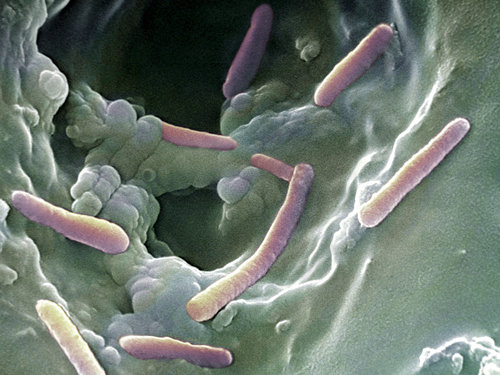PNAS:绿脓杆菌利用脂拉链入侵宿主细胞

绿脓杆菌在免疫系统较弱的人当中,可以引起严重的皮肤和肺部炎症,特别是那些患有遗传性疾病囊胞性纤维症的人。当细菌进入人体细胞后,Gb3脂质结合LecA蛋白并使细胞膜弯曲。荷兰瓦格宁根大学的Christian Fleck教授在新研究中通过计算得出,这种结合足以将细菌包裹起来。
之前,研究人员只熟悉细菌侵染的方法,包括操控宿主细胞内的信号。这项信号可控制肌动蛋白纤维——细胞的肌肉:这些纤维可使来自内部的细胞被膜弯曲,并形成膜泡,细菌被吸收进其中。
为了证明没有肌动蛋白该过程一样能运行,德国佛莱堡大学BIOSS生物信号研究中心生物研究所II的Thorsten Eierhoff博士和Winfried Römer教授带领的一个研究小组,观察了假单胞菌(Pseudomonas bacteria)对合成膜泡的影响。膜泡既不包含肌动蛋白,也不包含其他细胞组分,只有脂质Gb3。当离体膜停靠到表面上时,就在细菌周围折叠和关闭。然而,只有当细菌产生LecA蛋白时,才会发生这个包装过程。实验表明,假单胞菌使用这种脂质拉链,使其自身进入细胞,而无需操控肌动蛋白。
研究人员证明,LecA和Gb3对于细菌到人类肺细胞的入侵也非常重要:当这一对分子消失时,透过细胞的细菌数量减少了70%。这些研究结果使Römer的研究小组能够发现一种潜在的药物,来对抗绿脓杆菌。
原文摘要:
A lipid zipper triggers bacterial invasion
Thorsten Eierhoff, Björn Bastian, Roland Thuenauer, Josef Madl, Aymeric Audfray, Sahaja Aigal,Samuel Juillot, Gustaf E. Rydell, Stefan Müller, Sophie de Bentzmann, Anne Imberty, Christian Fleck,and Winfried Römer
Glycosphingolipids are important structural constituents of cellular membranes. They are involved in the formation of nanodomains (“lipid rafts”), which serve as important signaling platforms. Invasive bacterial pathogens exploit these signaling domains to trigger actin polymerization for the bending of the plasma membrane and the engulfment of the bacterium—akey process in bacterial uptake. However, it is unknown whether glycosphingolipids directly take part in the membrane invagination process. Here, we demonstrate that a “lipidzipper,” which is formed by the interaction between thebacterial surface lectin LecA and its cellular receptor, the glycosphingolipid Gb3, triggers plasma membrane bending during host cell invasion of the bacterium Pseudomonasaeruginosa. In vitro experiments with Gb3-containing giant unilamellar vesicles revealed that LecA/Gb3-mediated lipidzippering was sufficient to achieve complete membrane engulfment of the bacterium. In addition, theoretical modeling elucidated that the adhesion energy of the LecA–Gb3 interaction is adequate to drive the engulfment process. In cellulo experiments demonstrated that inhibition of the LecA/Gb3 lipid zipper by either lecA knockout, Gb3 depletion, or application of soluble sugars that interfere with LecAbinding to Gb3 significantly lowered P. aeruginosa uptake by host cells. Of note, membrane engulfment of P. aeruginosaoccurred independently of actin polymerization, thus corroborating that lipid zippering alone is sufficient for this crucial first step of bacterial host-cell entry. Our study sheds new light on the impact of glycosphingolipids in the cellularinvasion of bacterial pathogens and provides a mechanistic explication of the initial uptake processes.
作者:生物帮

